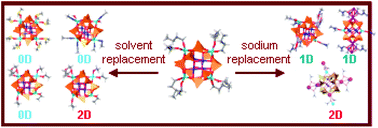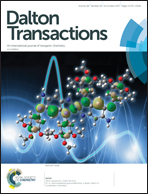Tuning linkage isomerism and magnetic properties of bi- and tri-metallic cage silsesquioxanes by cation and solvent effects†
Abstract
Herein, the effect of replacement of the surrounding solvent and/or the partial substitution of sodium ions in the cage-like copper, sodium phenylsilsesquioxane [(PhSiO1.5)12(CuO)4(NaO0.5)4(n-BuOH)6] 1 with a globular structure was investigated; the synthesis of ten new derivatives of complex 1 was performed, and their crystal structures were determined. Solvate replacement of n-butanol in 1 with dimethyl sulfoxide, acetonitrile, 1,4-dioxane/EtOH, and 1,4-dioxane/PhCN afforded the complexes [(PhSiO1.5)12(CuO)4(NaO0.5)4(DMSO)8] (2), [(PhSiO1.5)12(CuO)4(NaO0.5)4(MeCN)6(H2O)2]·2MeCN (3), [(PhSiO1.5)12(CuO)4(NaO0.5)4(C4H8O2)(EtOH)4]·0.5EtOH (4), and [(PhSiO1.5)12(CuO)4(NaO0.5)4(C4H8O2)4(H2O)3]·2PhCN·2C4H8O2·H2O (5). In an aqueous solution of EtOH, a rearrangement reaction occurred instead of substitution, which resulted in a new complex, [(PhSiO1.5)10(CuO)2(NaO0.5)2(H2O)6] (6), with a cooling tower molecular structure. Transmetalation reactions of 1 with KCl or CsF resulted in the formation of the trimetallic complexes [(PhSiO1.5)12(CuO)4(NaO0.5)2(KO0.5)2(DMF)6] (7), [(PhSiO1.5)12(CuO)4(NaO0.5)(CsO0.5)3(DMF)4(DMSO)(H2O)]·1.5DMF (8), [(PhSiO1.5)12(CuO)4(NaO0.5)2(CsO0.5)2(DMF)8]·0.5H2O (9), and [(PhSiO1.5)12(CuO)4(NaO0.5)3(CsO0.5)(DMF)4] (10). The replacement of sodium ions of 1 by the bulky non-metallic cation PhMe3N+ upon the interaction of 1 with PhMe3NCl in a MeCN medium afforded the complex (PhNMe3)2[(PhSiO1.5)12(CuO)4(NaO0.5)2(O)(MeCN)4]·4MeCN (11). X-ray analysis confirmed the successful replacement of terminal butanol molecules in all complexes and the stability of the globular cage of the parent complex under the reaction conditions, with the exceptions of complexes 6 and 9 that underwent an unprecedented reorganization of cage metallasilsesquioxane (CLMS) units into the cooling tower and sandwich-like cages, respectively. The stability of the cage during substitution reactions provides the first experimental evidence that polynuclear cage metallasilsesquioxanes can act as building blocks for the construction of coordination polymers, opening new ways for the synthesis of hybrid CLMS-based frameworks. In particular, the compounds 4, 6, 7, 9, and 10 are one-dimensional coordination polymers, and 5 and 8 are two-dimensional coordination polymers with a square lattice topology. A magnetism study of the coordination polymer compounds 5, 6, 8, and 9 showed antiferromagnetic behavior between copper centers.



 Please wait while we load your content...
Please wait while we load your content...